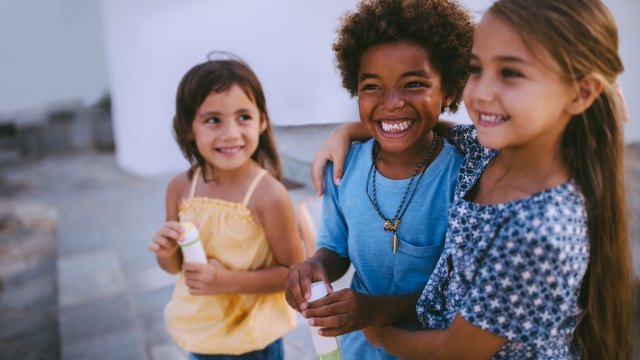“I felt jealous of the two of you,” I heard my eight-year-old daughter say to her two friends while they were huddling on the trampoline in our backyard. I was sipping my coffee and typing away at my laptop, but their conversation made my ears perk up.
“How come?” her bestie replied.
“I just didn’t want to be left out so I acted mean. I’m so sorry,” my daughter said.
“We want to play with you, too,” her friend responded.
I saw a smile stretch across my daughter’s face; and just like that, the three girls popped up on the trampoline to begin jumping and giggling. Wow, I thought, I could learn so much from them.
You see, this generation’s superpower is their vulnerability. They’re just so good at expressing emotions, naming them, and using them to navigate conflicts. But for many of us parents, leading with vulnerability is a new concept. Thanks, Brene Brown. We were raised to be “tough”—to hide our big emotions, even. Instead of naming what we were feeling and working past that discomfort, we stuffed it all down. If we skinned a knee, a friend somehow hurt us, or we felt out of sorts, we were told to “stop being a baby” and “toughen up.” The old-school way of handling our emotions was not handling them at all.
“A decade ago, no one spoke much about emotional vulnerability,” psychologist Dianne Grande noted in Psychology Today. “Being vulnerable emotionally was generally compared to being weak, or at least easily hurt or frightened. Maybe it was never discussed much because it is a natural, daily, unavoidable part of our existence as human beings, and frankly, it feels bad.”
Yet kids today aren’t afraid to confront those unpleasant feelings. With practice, they’re learning that if you approach uncomfortable emotions and allow yourself to feel them openly, like a river, they pass. Not only do some kids use this technique to help them feel better, but they use it to improve whatever situation is going on in their life. And they’ve been taught how to do so from an early age—through cartoon shows like Daniel Tiger and mindfulness lessons at school. Now they’re coming out the other end of difficult situations feeling in control. How empowering is that?
Not to mention, this brave act is deepening their friendships and in some cases, cluing them in to which friends may not necessarily be a safe place for them to land. Both of these are equally as important and something I desperately wish I had learned as a child.
But it’s never too late. That’s why I’m letting my kids help me unleash my own vulnerability. I’ve learned from them that those who truly love you will not only accept your openness but applaud it. Once you express how you feel, they’ll embrace you and want to help you move through it. They don’t want you to ignore the icky feelings or squash them like our generation did.
Is it scary? Heck yeah. As Brown explains, “emotional vulnerability is most often felt as anxiety about being rejected, shamed, or judged as inadequate.” And that’s terrifying for anyone at any age. No one wants to feel alone, or worse, rejected. But these kids we’re raising, they’re courageous.
What I’ve observed from my daughter, specifically, is that after a tiff with her best friends, their bond is woven tighter. After all, as Grande suggests, “allowing ourselves to be emotionally vulnerable is also a tremendous source of strength and the only way we can truly connect in our most personal relationships.”
And at the end of the day, isn’t connection what we most crave from the human experience? That’s why the next time I find myself at odds with my husband or needing to set a boundary with a friend, I’m going to channel my inner child and express my feelings. Because I know now that keeping my anger in only leads to resentment. And after letting it out to those I love, maybe our own connections will grow stronger, and we’ll feel like kids popping up on a trampoline, too.











